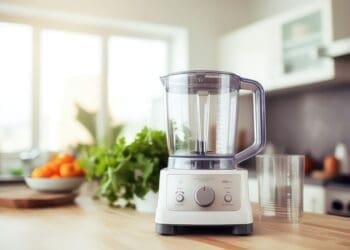Ice cream makers range from $22 to a whopping $1,200, which makes choosing the right one quite a challenge. Our tests of 32 different models revealed significant differences in how these machines perform. Some units can create frozen treats quickly in 20 minutes, while others need 24 hours of preparation time.
The market offers an impressive variety of options. Simple canister models sit alongside advanced compressor units that make ice cream at the touch of a button. Making ice cream at home lets you experiment with unique flavors that stores don’t carry. We’ll help you weigh the actual costs and benefits of homemade versus store-bought ice cream, so you can decide if an ice cream maker belongs in your kitchen.
Understanding Ice Cream Maker Types

The right ice cream maker can make all the difference to your frozen treats. Let’s look at the simple types you can find and what makes each one special. You’ll find two main types in stores: canister and compressor models.
Canister vs Compressor Models
Canister models, which people also call freezer bowl machines, come with four simple parts: a motorized base, a removable canister, a churning paddle, and a lid. These machines use a special non-toxic saline solution inside their aluminum and plastic walls that works like a cylindrical ice pack. You’ll just need to pre-freeze the canister for at least 24 hours before use. This step will give a perfect temperature to chill your ice cream base properly.
Compressor models come with built-in refrigeration technology that can get as cold as -22°F (-30°C). These self-cooling units let you make ice cream whenever you want – no pre-freezing needed. It also makes multiple batches one after another without extra frozen bowls or waiting time.
Price Ranges for Different Types
Ice cream makers come at very different price points. Simple canister models cost less because their technology isn’t as complex. These machines start at $30 to $40, making them available to people who make ice cream once in a while.
Compressor models cost more because they pack more advanced features and convenience. You’ll find entry-level compressor units starting around $200, while professional-grade equipment can go up to $1,200. Some popular options include:
- Breville’s Smart Scoop at $600
- Whynter’s range from $200 to $600
- Cuisinart’s compact compressor model at $300
Canister models work great for most home cooks who make frozen treats now and then. In spite of that, if you love making ice cream often, a compressor model might be worth the extra money.
Your choice between these types depends on what matters most to you. Canister models need more planning but give great value and results. Compressor models are super convenient but take up more counter space and cost more. Both types usually make about 1.5 quarts per batch, though some models like the Cuisinart Total Indulgence can make up to 2 quarts.
Store-Bought Ice Cream Cost Analysis

Store-bought ice cream prices vary based on brand quality and how much people buy throughout the year. The market has ice cream of all types, each with its own price point and features.
Premium Brand Prices
Super-premium ice cream brands cost more because they use better ingredients and have a special manufacturing process. These products contain 15-18% butterfat content and less air, which makes them denser and richer. To cite an instance, a pint of Ben & Jerry’s costs about $11.49. Store brands usually cost half that amount.
The prices change a lot depending on quality:
- Economy brands: $0.30-0.42 per serving
- Standard brands: $0.54-0.67 per serving
- Premium brands: $1.33 per serving
Ice cream prices keep going up steadily. A half-gallon of ice cream now costs $6.46 on average, which is much higher than before.
Yearly Ice Cream Spending
American families keep taking ice cream home throughout the year. Recent stats show each consumer unit spends $98.67 yearly on ice cream. This includes both ice cream bought at stores and premium purchases.
Here’s what the numbers tell us:
- People eat 12.7 pounds of ice cream yearly
- Half-gallon costs $6.02 these days
- Ice cream adds $11.40 billion to the U.S. economy
Cities have different ice cream prices. Philadelphia has the most expensive scoops at $5.35. Midwest cities like Sandusky, Ohio offer better deals at $3.50 per scoop. These price differences affect how much families spend yearly, especially those who buy ice cream often.
The ice cream market should grow from $71.52 billion to $104.96 billion by 2029. This growth and rising prices make it important to know whether store-bought or homemade ice cream saves more money.
Real Cost of Making Ice Cream at Home

The real cost of making ice cream at home goes beyond just buying a machine. Let’s get into what you’ll actually spend to create your favorite frozen treats.
Original Machine Investment
Your ice cream maker’s price tag depends on what features you want. The Cuisinart ICE-21 starts at $75, which is perfect for beginners. Serious ice cream lovers might want to splurge on something like the Lello 4080 Musso Lussino that delivers professional-quality results.
Ingredient Expenses
Quality ingredients shape your ice cream’s cost. A simple vanilla ice cream using premium ingredients costs about $2.45 for 1.5 quarts. Here’s what you’ll typically pay:
- Organic cream: $6.79 per half-gallon ($0.85 per cup)
- Whole milk: $2.55 per gallon ($0.15 per cup)
- Organic sugar: $0.80 per cup
Fancy flavors will cost you more. To cite an instance, vanilla extract adds $6-7 per batch, and pistachio paste can bump up your recipe cost by $15.
Energy Usage Costs
Your power bill takes a hit when making ice cream. Traditional soft-serve machines use between 15,175 to 44,325 kWh annually. This is a big deal as it means that operating costs range from $7,569.29 to $22,109.31 each year at current commercial rates of 49.88p per kWh.
Home ice cream makers are the quickest way to save on energy. These machines use about 1,269 kWh annually, which translates to $632.97 in yearly power costs. Monthly bills usually run between $500 to $1,500, depending on how much you use your machine and local power rates.
Home ice cream making becomes cheaper the more you use your machine. Simple flavors like vanilla or chocolate cost about $1.70 per pint to make. Store brands like Ben & Jerry’s are no match for homemade ice cream at $4.48 per pint. Regular ice cream makers can earn back their investment through these savings between homemade and store-bought options.
Quality and Control Benefits

Making ice cream at home opens up possibilities that store-bought versions can’t match. You get complete control over everything – from picking top ingredients to creating your own flavor combinations.
Ingredient Selection Freedom
The foundation of homemade ice cream comes from simple, everyday ingredients like whole milk, heavy cream, and sugar. Store-bought varieties need preservatives and chemical additives to last longer. Your homemade version tastes cleaner and more authentic.
Good ingredients make better ice cream. Using organic dairy and natural flavors creates a superior taste. To name just one example, real vanilla beans give much richer flavors than artificial extracts.
People with dietary restrictions can choose non-dairy options. Ice cream makers work well with different milk substitutes like coconut, cashew, or oat milk. This means everyone can enjoy fresh, homemade frozen treats, whatever their dietary priorities.
Take advantage of new articles, click here.
Customization Options
The real magic happens with endless ways to customize your ice cream. Simple recipes work as blank canvases for creative experiments. Here’s how to improve your ice cream:
- Use stabilizers like xanthan gum or milk powder to get better texture and longer shelf life
- Cook fresh fruits with sugar to achieve perfect consistency
- Add cocoa powder, toasted nuts, or brownie pieces for varied texture
You control exactly how sweet your ice cream should be. If you add caramel or candy, you can reduce the base sweetness to balance flavors. Tart fruits might need extra sugar to taste just right.
The ice cream-making process lets you create beautiful flavor layers. Instead of mixing everything together, adding ingredients in layers creates ribbons of flavor throughout. Each scoop will have distinct pockets of taste.
Best of all, you know exactly what goes into your ice cream. Without artificial thickeners or unnatural stabilizers found in store versions, your ice cream tastes remarkably fresh and pure. This control over ingredients helps you create ice cream that’s delicious and matches your exact taste.
Conclusion
Making ice cream at home saves money and has several advantages over store-bought options. A pint of premium store-bought ice cream costs around $11.49, but you can make the same amount at home for just $1.70. These savings add up quickly if you love ice cream.
The quality you get from homemade ice cream is a great reason to make your own. You can create custom flavors with fresh ingredients instead of mass-produced options full of preservatives. You control the sweetness and can adapt recipes to fit dietary needs, which leads to professional-quality results.
Ice cream makers need an original investment of $75 to $1,200, but they’re worth it for many families. Simple canister models work well for occasional use. Serious ice cream lovers might want to spend more on compressor units that offer more convenience and flexibility.
Your priorities will help you choose between store-bought and homemade ice cream. Our testing shows that making ice cream at home gives you better value, higher quality, and lets you experiment with endless flavor combinations. The creative possibilities are limitless when you make your own frozen treats.
FAQs
Q1. Is making ice cream at home more cost-effective than buying it from the store?
While homemade ice cream can be more expensive for basic flavors, it becomes more cost-effective for premium varieties. A homemade pint costs around $1.70, compared to $4.48 for premium store brands. The initial investment in an ice cream maker can be recouped over time through these savings.
Q2. What are the quality benefits of homemade ice cream compared to store-bought?
Homemade ice cream offers superior quality control. You can use fresh, high-quality ingredients without preservatives or additives. This results in a cleaner taste and the ability to customize flavors and accommodate dietary restrictions, which is often not possible with store-bought options.
Q3. How much does an ice cream maker typically cost?
Ice cream maker prices vary widely based on type and features. Basic canister models start around $75, while high-end compressor units can cost up to $1,200. Mid-range options with good features are available between $200-$600.
Q4. What types of ice cream makers are available for home use?
There are two main types: canister models and compressor models. Canister models require pre-freezing and are more affordable, starting at around $30-$40. Compressor models are more expensive but offer convenience with built-in refrigeration, allowing for spontaneous ice cream making.
Q5. How does the texture of homemade ice cream compare to store-bought?
Homemade ice cream often has a denser texture compared to store-bought varieties. This is because commercial ice cream incorporates more air during production, resulting in a lighter consistency. Homemade ice cream typically has less air, leading to a richer, creamier texture.





















































